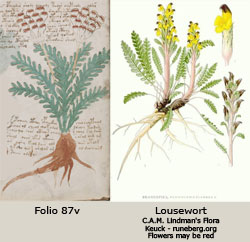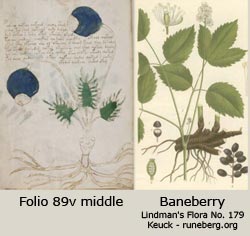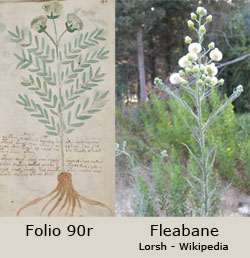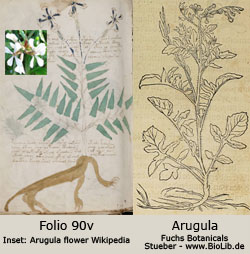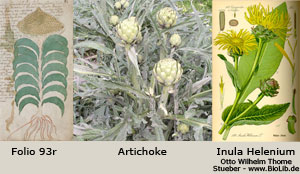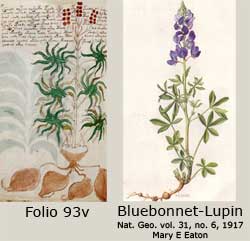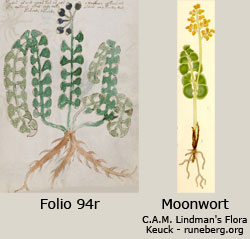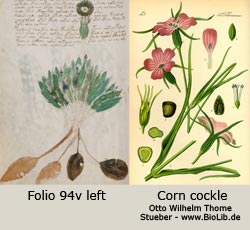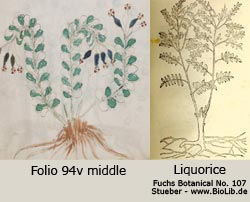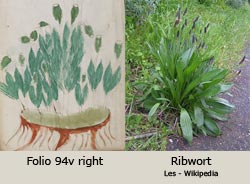The Voynich Botanical Plants
Folio 87v, Lousewort or Wood Betony (Pedicularis flammea), is found throughout the Northern Hemisphere. Its extensive root system is semi-parasitic on the roots of other plants. The leaves are alternate and bipinnate; the bilaterally symmetrical flowers grow in racemes. The name lousewort comes from the belief that when cattle ate this plant they became infested with lice.
Folio 89v middle, Baneberry or bugbane (Actaea spicata), is a very poisonous, bad smelling, member of the ranunculus family. It has creeping black roots that each year send up erect stems with triangular, toothed, compound leaves, that end in a spike of white flowers. The fruit is a fairly large glossy, black berry. The whole plant is poisonous. The juice of the berries, mixed with alum, yields a black dye.
Folio 90r, Fleabane (Conyza bonariensis), is native to most parts of Europe. The stems are erect and woody with alternate, arrow-shaped leaves. The plant has a taproot and each stem has several clusters of white flowers. The plant has a slight aromatic odor which is said to destroy fleas.
Folio 90v, Arugula or Rocket (Eruca vesicaria), a member of the cabbage family, has been grown in the Mediterranean area since Roman times. It has a slender taproot; stiff, erect, pubescent stem; coarsely toothed or lobed leaves; and creamy white, four-petal flowers with purple veins. The plant is considered to be an excellent stimulant and aphrodisiac and was used in a mixed salad by the early Romans. This folio illustrates the VM author’s prankish nature when he represented the roots of this plant as a headless cat.
Folio 93r, Artichoke (Cynara cardunculus), was cultivated by the Greeks and Romans over two thousand years ago. It is a perennial thistle with a tuberous root and a blue thistle flower at the end of a tall erect stalk with alternate thistle leaves. Although the flower of folio 93r resembles that of an artichoke, the leaves and the root do not. Elecampane or Horse-heal (Inula Helenium) is a sunflower-like plant found growing wild throughout Europe, particularly Southern Europe. It grows to a height of from 3 to 5 feet; the leaves are large, the lower ones stalked, the rest embrace the stem. The many yellow ray flowers are two inches in diameter and the root is thick and branching. The ancients used the root as both a medicine and a condiment. This plant represents the plant in folio 93r much better than a globe artichoke.
Folio 93v, Lupin (Lupinus), we have used a Texas Bluebonnet as an example of a wild lupin. Lupins are found in the Mediterranean and Africa. Their leaves are usually palmate and the many-colored, pea-shaped flowers form open whorls at the end of an erect spike. The plant is symbiotic with nodule bacteria which fix nitrogen and are found in rhizoids associated with the plant root structure. The Romans cultivated lupins for food. Pliny observed: “No kind of fodder is more wholesome and light of digestion than the White Lupine, when eaten dry. If taken commonly at meals, it will contribute a fresh colour and a cheerful countenance.” (Grieve, M.,)
Folio 94r, Moonwort or Moonfern (Botrychium lunaria), is found in cold and temperate zones all over the world. It is a small fern with fleshy roots. Its fronds are pinnate with 3 to 8 pairs of rounded leaves and a fertile spike that is completely covered with brown spore cases when it is ripe. This plant is on the endangered species list. Legends claim it can raise the dead, open locks, and unshoe horses that tread on it. This folio was identified by Dana Scott.
Folio 94v left, Corncockle or Red Campion (Agrostemma Githago), is a weed widely distributed in the cornfields of Europe. The plant’s long, narrow, lance-shaped, stemless leaves are produced in pairs; the slender stems end in a single magenta flower. The flower’s leaf-like calyx is very long and narrow with five strong ridges and five long green teeth that are longer than the magenta petals. Corncockle was once considered a cure for dropsy and jaundice.
Folio 94v middle, Liquorice (Glycyrrhiza glabra), a native herbaceous perennial of Southern Europe, is a member of the legume family. The pinnate leaves have 9-17 leaflets and the pale purple flowers are produced in loose bunches. Liquorice is popular in Italy and Spain where the plant’s root is chewed as mouth-freshener. Liquorice extract for making candies, is produced by boiling liquorice root and subsequantly concentrating the extract.
Folio 94v right, Ribwort, Plantain, or Kemps (Plantago lanceolata), is a perennial European herb with long lance-shaped basal leaves that have 3-5 strong parallel veins. The flower stalks are often more than 2 feet long, terminating in blunt cylindrical, spikes. During mediaeval times children used these flower spikes to play a game called kemps. The game involved striking one stalk head against another until a stalk broke. Kemps (cempa) was the Anglo-Saxon word for soldier. Ribwort is used in tisanes and other beverages.
